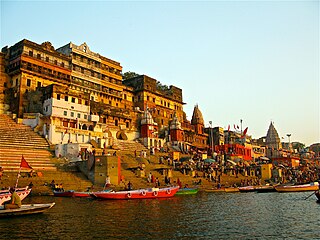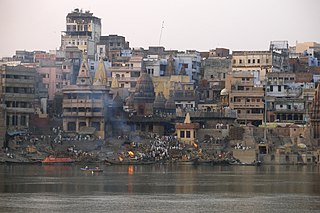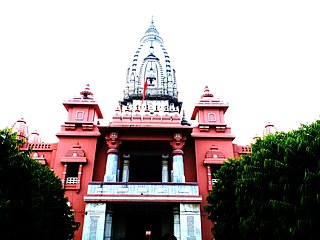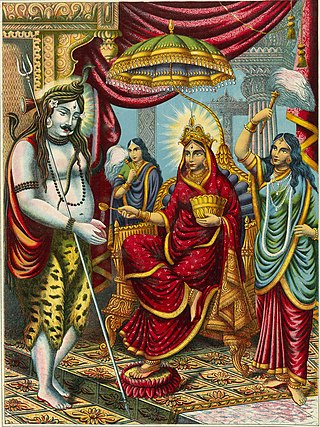
Kashi Vishwanath Temple is a Hindu temple dedicated to Shiva. It is located in Vishwanath Gali, in Varanasi, Uttar Pradesh, India. The temple is a Hindu pilgrimage site and is one of the twelve Jyotirlinga shrines. The presiding deity is known by the names Vishwanath and Vishweshwara, meaning Lord of the Universe.

Ahilyabai Holkar, also spelled Ahalya Bai, was the Rajamata and later the ruling queen of Indore within the Maratha Confederacy. She established Maheshwar as the seat of the Holkar Dynasty. A beloved figure of Indian history, she is renowned for good governance, social welfare, and humanitarian work along with religious, educational, and cultural advancements. She contributed to the growth of Indian architecture through the commission of various temples, Ghats, and Dharmshalas. Ahilyabai's Matha, or charitable endowments, spread across India. Remembered as a Sadhvi, or holy woman,

The Vishalakshi Temple, also known as Vishalakshi Gauri Mandir and Vishalakshi Amman Kovil. It is one of the famous Hindu temple at Varanasi. Dedicated to the goddess Vishalakshi. It was Built and Maintained by Nattukottai Nagarathar a mercantile community from Tamil Nadu

Maharaja Vibhuti Narayan Singh was the king of Benares, a city considered holy, located in the Indian state of Uttar Pradesh. He was the last Bhumihar king of the Kingdom of Kashi.

The Ramnagar Fort is a fortification in Ramnagar, Varanasi, India. It is located near the Ganges on its eastern bank, opposite to the Tulsi Ghat. The sandstone structure was built in 1750 by Kashi Naresh Maharaja Balwant Singh. The current king and the resident of the fort is Anant Narayan Singh, who is also known as the Maharaja of Benares even though this royal title has been abolished since 1971.

Scindia Ghat is one of the ghats in Varanasi and borders Manikarnika, a place of Hindu cremation, to the north. At this ghat, a tilted Shiva temple can be found lying partially submerged in the Ganges River and it is argued that this ghat collapsed under its own excessive weight. The ghat is named after the Scindias, who built it in 1830. Above the ghat, several of Kashi’s most influential shrines are located within the tight maze of alleys of Siddha Kshetra. According to mythology, Agni, the Hindu God of Fire, was born here. Hindu devotees propitiate at this place to Vireshwara, the Lord of all heroes, for a son.

The Sapta Puri are a group of seven Hindu tirtha, or holy pilgrimage sites, located in India. Pilgrimage to these sites is said to bless the pilgrim with moksha.

Ghats in Varanasi are riverfront steps leading to the banks of the Ganges river. The city has 84 ghats. Most of the ghats are bathing and puja ceremonial ghats, while two ghats, Manikarnika and Harishchandra, are used exclusively as cremation sites.

Manikarnika Ghat is one of the holiest cremation grounds among the sacred riverfronts (ghats), located on the banks of River Ganga, in the city of Varanasi in the Indian state of Uttar Pradesh. In Hinduism, death is considered a gateway to another life marked by the result of one's karma. It is believed that a human's soul attains moksha, and hence breaks the cycle of rebirth when cremated here.

Varanasi is a city on the Ganges river in northern India that has a central place in the traditions of pilgrimage, death, and mourning in the Hindu world. The city has a syncretic tradition of Islamic artisanship that underpins its religious tourism. Located in the middle-Ganges valley in the southeastern part of the state of Uttar Pradesh, Varanasi lies on the left bank of the river. It is 692 kilometres (430 mi) to the southeast of India's capital New Delhi and 320 kilometres (200 mi) to the southeast of the state capital, Lucknow. It lies 121 kilometres (75 mi) downstream of Prayagraj, where the confluence with the Yamuna river is another major Hindu pilgrimage site.

Ravaneshwar Mandir is one of the most famous temples in the holy city of Varanasi. This temple has great historical and cultural importance in Hinduism.

Shri Tilbhandeshwar Mahadev Mandir, also known as Tilbhandeshwar Mahadev Mandir and Tilbhandeshwar Mandir, is one of the oldest and most famous temples in the holy city of Varanasi. This temple has great religious importance in Hinduism and is dedicated to the Lord Shiva. Tilbhandeshwar Mandir is believed to be constructed in 18th century.

Shri Vishwanath Mandir also known as Vishwanath Mandir, Vishwanath Temple, New Vishwanath Temple and Birla Temple is another prominent Hindu temple in the holy city of Varanasi. Hindus across India and abroad visit this particular Lord Shiva temple to offer prayer to the Lord Vishwanath for the well-being of their families, and eternal peace. Every Hindu must perform a specific ritualistic homage for the departed souls of their ancestors this requires them to undertake pilgrimage to the holy city of Varanasi. The temple is situated near the Banaras Hindu University. Therefore, the temple site and the neighbourhood is a major attraction among Hindu students and visitors touring Varanasi. Shri Vishwanath Mandir has the tallest temple tower in the world with the Shikhara's height being around 250 feet. The temple is colloquially called VT, an acronym of Vishwanath Temple. The temple is under direct administration of the BHU.

Annapurna Devi Mandir, also known as Annapurna Mata Mandir and Annapurna Mandir, is one of the most famous Hindu temples (Mandir) in the holy city of Varanasi. This temple has great religious importance in Hinduism and is dedicated to the goddess Annapurna. Annapurna is the Hindu goddess for nourishment and is a form of the goddess Parvati. The current Annapurna Mandir was constructed in the 18th century by Maratha Peshwa Bajirao I.

Shri Samrajeswar Pashupatinath Mahadev Mandir, also known as the Nepali Mandir, Kanthwala Mandir and Mini Khajuraho, is one of the oldest and most famous temples in the holy city of Varanasi. This temple has great religious importance in Hinduism and is dedicated to the Lord Shiva. Constructed in the 19th century A.D by the King of Nepal, the temple is made of terracotta, stone and wood and is replica of the Pashupatinath Temple in Kathmandu.
Varanasi, also known as Kashi, is considered as the religious capital of Hinduism. In the Hindu faith, it is the holiest of all of its cities; the four dhams in the four cardinal directions of the country – Badrinath in the north, Puri in the east, Dwarka in the west and Rameshwaram in the south – are all represented in the city in "archetypal forms" as the presiding deities at Badrinath Ghat, Assi's Jagannath Temple area, Shankudhara Pokhra, and Mir Ghat respectively. Other Hindu holy places, such as the Kedarnath at Kedar Ghat, Mathura at Bakaruia Kund or Nakhi Ghat, Prayagraj (Allahadbad) at Dashahvamedha Ghat, Kamakhya (Assam) at Kamachha, Kurukshetra at Kurkukshetra Kund near Asi, and Lake Manasarovar at Mansarovar near Shyameshvara are a part of the city's religious and cultural heritage.

Lalita Ghat is one of the main ghats on the Ganges River in Varanasi. The ghat is named after Hindu Goddess Lalita and was built in early 19th century by King of Nepal, Rana Bahadur Shah. The ghat houses the famous Nepali Mandir and Lalita Gauri Mandir.
Lalita Gauri Mandir, also known as Lalita Mata Mandir, is one of the important and historic temples in the holy city of Varanasi. This temple has great religious importance in Hinduism and is dedicated to the goddess Lalita Gauri. The Mandir was constructed in early 19th century. The temple was constructed between 1800–1804 by Rana Bahadur Shah. Lalita Gauri Mandir is situated on the Lalita Ghat and the ghat was named after this temple.

The Shri Kashi Karvat Mandir is one of the Dwadesh Jyotirlingas temple. It is a few meters away from Kashi Vishwanath Temple. It is an ancient Shiva temple. It is an important temple and visited by many Hindu devotess who visit Kashi Vishwanant Temple.
























